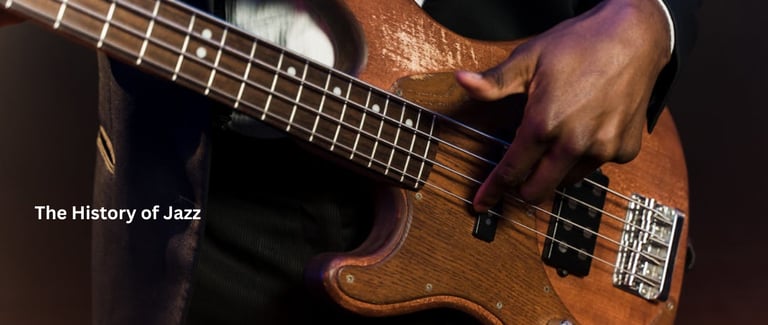The History of Jazz Top Books for Music Lovers
1/15/20256 min read


"The History of Jazz: Top Books for Music Lovers"
For nearly a century, a genre has evolved that has dramatically altered the cultural landscape of the 20th century and well into the next. The history of jazz is one of innovation, rebellion, and expression-from its early days in New Orleans African-American communities to becoming a global force. If one is the admirer of this style then reading these lines most probably will know one of the best ways how to collect as much information and depth of this style of origins, key players are and how they somehow influenced dramatics on the musical scene. That reason being, here's the way in which some of the most amazing books on jazz history go even into exactly what any zealous music aficionado would actually find necessary to read into:
Introduction: The Lush History of Jazz
This living history could be traced from the end of the 19th and at the beginning of the 20th century because this is when the culture was born in New Orleans but flowered into great cities like Chicago and New York, where it found multiple forms in the forms of bebop, swing, and cool jazz. Other forms of music that are forming in jazz are blues, ragtime, and European classical.
It is not what one hears but learns about its history, culture, social, and political context. And from the struggle for civil rights to the advent of avant-garde styles, one might even say that jazz always reflected times. Good amounts of literary resources exist in the interest of jazz history, meaning one is able to get knowledge about origins, famous names, and in general, about how it has all been fitted together to present us with music like we do today. In a case when someone hasn't listened to much jazz for ages, or indeed has never before; it is here in these resources where one grasps the meaning behind this art.
A History of Jazz: Read To List the Books That Formerly Comprised Fairly Quite In-Depth Histories Regarding the Subject Of Jazz Composed With Spectacular Theoretical Know-How The First Accounts The Accounts Came From the Mouth of the Musicians as well as Critics and even Scholars too.
A History of Jazz: Read By Geoffrey C. Ward and Ken Burns
Dubbed Jazz: A History of America's Music, this is the book and documentary about jazz. From the same-titled documentary series, this book sweeps the reader along a tour of history and history of jazz. The best jazz historians and critics contribute their expertise to achieve an in-depth analysis of the genre and its pioneers.
Major features
•Timeline of jazz from its origins to modern styles.
• The Greats Biographies: Louis Armstrong, Duke Ellington, and Charlie Parker.
• Images and Photographs Vividly Describe the Cultural History of Jazz.
Why You'll Love Reading This:
This is a great, readable history of the form-for fans both old and newly made whose appreciation has yet to lead to either enjoyment in its sounds, but who have yet to enjoy or who have heard, to begin to hear its message. A Fine History of Jazz Illustrates Its Architects. Other title that could also be applied to a jazz history book is The History of Jazz by Ted Gioia. It is too broad, research-based writing since Gioia looks at a chronological history of jazz from rudimentary figures and the musical movements that count. The author writes in an academically interesting style hence this book would be recommended for readers who intend to have deeper insight into the genre.
Major Features:
Music: History and Analysis Why you should read
Most book reviewers agree that Gioia's The History of Jazz is among the best on the shelf. What it does is provide a readable and authoritative account of the history of the form that will make it indispensable to both scholars and aficionados alike. Of all that had to go into this making, this is one extremely insiderish documentation on how an album came together but still, as usual leaves much unsaid about the life of the man and the time in which that record came.
Features
•Stories about the creation of Kind of Blue, a landmark in the history of the jazz album.
•Davis's account of creativity and relationships with members of the band.
•The musicians who played as well as the engineers who recorded them.
Why Read It
A must-read for Miles Davis fans and for any reader fascinated by the creative processes behind one of the most iconic jazz records. It's a pretty unique glimpse into the process of Kind of Blue as well as robust insights into the revolutionary approach Davis brought to the music of jazz.
Read First Book: Of course, he's one of the most important jazz musicians ever to emerge out of the 20th century, so Kelley's book is an exhaustively personal and scholarly study of Monk's life and times.
Thelonious Monk: The Life and Times of an American Original gives all the information about Monk and his life in musical composition, personality, and every struggle as an African-American artist in the setup of society.
Major Features: Exhaustive biography of Thelonious Monk
• Finding personal musical style with Monk and his contribution to this world of jazz.
• Personalization with Monk and struggle
Why You Want to Read This:
Kelley's biography is just so wonderfully revealing of an actual, multi-scaled view about one of jazz's most mythological figures: any serious player of Monk interested in his sound, but for people especially seeking insight into such complex topics, the intersections, or lack of, race-identity-creativity, then everybody must read Kelley's.
John Szwed. "Billie Holiday: The Musician and the Myth.
Maybe the life of Billie Holiday stands solitary above that of any other major jazz vocalist, so singularly accomplished and so horrifically marked by personal calamity. Another compellingly interesting book about Billie Holiday and her legendary singing career in music is critical deconstruction from John Szwed. More than a music critical analysis alone it looks even deeper to social and cultural forces shaping this life and this art.
Major Features:
•A very long biography of Billie Holiday.
•Intimate analysis of how sound, race, and gender became intertwined in the life of Billie Holiday.
•Analytical critique of the singing style and impact on jazz of Billie Holiday.
Why Read It
This is a rich and exciting biography that opens up the life and career of Billie Holiday. It is interesting to all who have enjoyed music and know how the cultural relevance of the Holiday music becomes useful in an explanation of how it explains the fight as a female African American woman in an America of segregated entities.
Jazz Genres: Sound Evolution
At least that many descriptions of all the most important and subcategories would be required since all of them have given their face to the sound in time, having all their idiosyncrasies and massive influence on the development of jazz.
Swing
Swing music began in the 1930s and is to this day, the best American jazz recorded up to the Big Bands period. Swings are brisk in pulse and robust and sumptuous melodic lines, and its most influential exponents have been Duke Ellington and Count Basie.
Bebop
It completely transformed the face of jazz as it was marked with swift tempos, intricate harmonies, and improvisations in the 1940s. This gave a new direction taken into their making of jazz by Charlie Parker and Dizzy Gillespie and many more to intellectualize and advance the avant-garde of jazz.
Cool Jazz
Cool jazz appeared in the late 1940s and early 1950s. In fact, relatively cool jazz-pretty laid-back with matured arrangements-and quite typically, of course, exponent Miles Davis, Chet Baker, among a great many other. The counterpart, of course was bebop-actually the extreme opposite end of the energy scale.
Modal Jazz
These include free jazz: This kind of music was primarily developed in the late 1950s and early 1960s, by Miles Davis and John Coltrane. In other words, instead of chord progression, it generally is constructed by improvisations of scales or modes. For example, there is Kind of Blue, which just happens to become an example for modal jazz. Free jazz- idiomatic use of the composition in the 1960's, and obviously was inevitable to be invented as the free form of creativity. Some vanguard artists who were the reflection of this very new vanguard that sought for how to apply their melodic, harmonic and rhythmic virtuosity were, absolutely without any concern Ornette Coleman and Albert Ayler.
Influence on Culture-Jazz
Culture tentacles reach touch lives in these United States-and resounds from inside the international perspective. From its influence that came into the fray when civil rights had a voice and which it has its echo resounding in the African-American communities clear and loud as can be heard with all the differences existing in the rocks, funk, and hip-hoppers that have manifested themselves long after. It is along with the formation of jazz and the cross-cultural communication started opening up too with it.
Conclusion: Jazz History Through History
Jazz is, at the very least, a genre of music, yet above all it represents a very specific part of culture that in due course causes history to alter. The whispers in New Orleans have grown very loud around the world. A way, even easily come, to the appreciative mind, nevertheless, one man will find through stories related to the historical background of such jazz, and he will accept it as the form of a much deeperly influenced art throughout the world. Any reader interested in more of the history of jazz and tremendous musicians who delineate the sound would read those books. Story behind albums, going through into giving insight in your understanding of jazz, and this literature can be read
which is of such cultural and elemental importance.







